How to Repair your Dishwasher by Yourself
How to Repair your Dishwasher by Yourself
The Dishwasher is a necessary in today’s life. We understand how important it is to have it in a perfect and effective condition. Our engineers are trained to do repairs and full service for most makes dishwashers such as a BOSCH,MAYTAG,MIELE ,SAMSUNG,KITCHEN AID,LG,GE,WHIRLPOOL,THERMADOR.
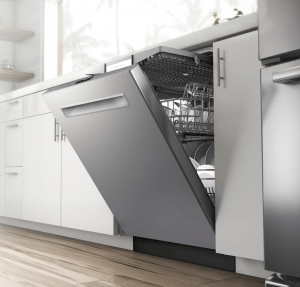
Whether you have a dishwasher which is not draining, is not completing it’s cycle, or something else, our knowledge and close and direct relationship with manufacturers means we are best placed to get your appliance back up and running quick!

If you’re looking for expert dishwasher repair services, be sure to call 911 Appliance Repair Services at (647)334-7733 today.
Common Dishwasher Faults:
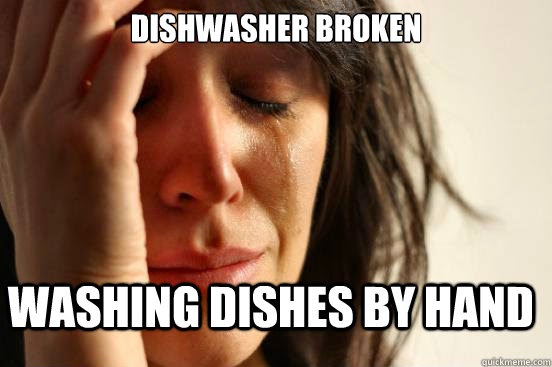
- No power
- Shows error codes
- Not draining
- Stops mid-cycle
- Not washing properly
- Door seal ripped
- Broken door
- Trips electric
- Not filling
- Noisy
- Door seal fault
- Not starting
Repair Your Dishwasher Yourself
How to troubleshoot and repair common dishwasher problems, including a dishwasher that doesn’t run, fill or drain. Also, how a dishwasher works.
A.DISHWASHER DOES NOT DRAIN
Following a cycle, a small pool of clean water inside the tub is normal. An excessive amount of water indicates an improperly-working pump, a clogged drain hose, or the clogged house drain lines.
If dirty water spews from the air gap, check the drain line for a kink or clog. (If you’ve recently installed a garbage disposer, be sure the knockout plug for the dishwasher was removed when the connection was made; see your disposer instructions.)
Remove the cover from the air gap at the top of the sink (usually a short chrome domed cylinder that sits at the back of the sink), and, using a stiff wire, clean it out. Also check the entire length of the drain hose for kinks or blockages, especially at the drain connection to the disposer or drain line.
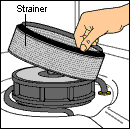
Lift out the strainer at the base of the dishwasher.
Once the dishwasher is cool, shut off the power to it, and—if your dishwasher is made to allow this—remove the strainer (shown at right), located under the bottom spray arm at the base of the cabinet. Unscrew the hubcap, lift the spray arm off, and remove any clips that hold the strainer to get it out. Scrub it clean with a brush and then replace it.
Determine whether the sink trap or house drain line is clogged. If the sink backs up, you’ll need to check for a drain clog.
If the dishwasher still doesn’t drain properly, the drain hose may be clogged or the drain valve may need replacement. You can check the drain hose for obstructions, but this usually involves pulling the dishwasher out from under your counter to access the hose, disconnecting the hose at both ends, and flushing it out with a faucet or garden hose, or replacing it with a new hose .
B.DISHWASHER DOES NOT FILL
If your dishwasher runs but doesn’t fill, either something is wrong with the water supply system or it is draining water too soon.
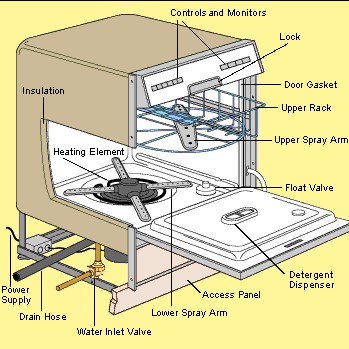
Dishwasher Diagram
Make sure to turn on the water supply. Check the hot water supply stop valve, normally located under the sink. Open it all the way by turning it counterclockwise. If you can’t think of any reason this would have been turned off since the last time the dishwasher worked, go on to the next step.
Turn off the power to the dishwasher. When the dishwasher is cool (in other words, not right after a wash cycle), look for the float inside the dishwasher. The float is usually a small plastic dome or cylinder mounted inside at the tub’s base, near the front. When you move most types of floats up and down, you can hear them click because their spring-loaded action trips a lever. Lift out the float mechanism, and clean around the float tube. Many floats require disconnection from below; to do this you’ll have to remove the lower access panel. Rinse off the float, replace it in the tube, and make sure it moves up and down freely.
Check the water inlet valve. Shut off the hot water valve to the appliance. Locate the dishwasher water inlet valve, behind the dishwasher’s bottom front panel. Disassemble the valve to reveal the screen. Clean any debris from the screen and reassemble the valve. If the screen appears clear, call an appliance repair person. Any of several parts—including the water inlet valve, pressure switch, and timer or selector switch—may be faulty.
C.DISHWASHER DOES NOT RUN
If you turn on the dishwasher and absolutely nothing happens, it may not be receiving electrical power.
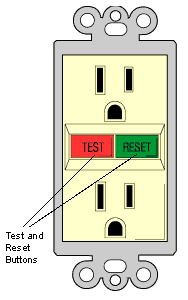
Reset the ground-fault circuit interrupter (GFCI).
Be sure the power is on, the door is latched, and the control is engaged. If absolutely nothing happens—in other words, nothing on the control panel lights up and there are no other signs of life—the appliance may not be receiving power.
Look where the dishwasher’s cord plugs into a receptacle, usually under the sink. Check to see if that outlet is a GFCI receptacle with a reset button. If the receptacle has a reset button, push the reset. In the condition where the receptacle doesn’t have a reset, or where the dishwasher’s cord is hard-wired directly into the electrical box, look for another receptacle nearby that has a reset and and try resetting it. (This is a long shot, but it’s easy to do and may solve the problem if the dishwasher is on the same circuit.) To test a receptacle for power, just plug a working hand-held appliance into it.
Check the electrical panel that serves the dishwasher for a tripped circuit breaker or blown fuse. If you find one, switch the breaker to OFF and then back to ON to reset the breaker, or replace the fuse.
Check dishwasher switches & timer. If electrical power is available to the dishwasher but the appliance doesn’t run, the problem is likely a defective door switch, timer, or selector switch. To solve a door switch problem, you may be able to adjust the door latch’s strike slightly, using a screwdriver (turn off the power to the dishwasher at the electrical panel first). If the problem is with the timer or selector switch, it’s best to call an appliance repair person.
D.HOW A DISHWASHER WORKS?
Despite the magic it performs in the kitchen, a dishwasher is actually quite simple—it is essentially a watertight box that sprays dishes with hot water and soap, drains out the dirty water, and then dries the dishes.
All of this is operated by controls that may be very simple or quite complex. The controls tell the system when to spray, when to release detergent from a dispenser, when to extract water from the tub and pump it back through the system, when to rinse and remove the rinse water, and when to turn on the heating element.
Hot water travels to the interior of a dishwasher through a supply hose that connects to a water supply valve, typically mounted under the sink. To shut off the water to the dishwasher, you close this valve. The other end of the supply hose connects to a water inlet valve inside the dishwasher. The inlet valve, electronically connected to the controls, opens and closes to supply water to spinning spray arms. These spray arms, usually at both the top and bottom of the tub, are like a high-pressure sprinkler system that sprays the dishes clean.
Dirty water collects at the base of the interior chamber, moves through a filter, and gets pumped back through the system during the early wash cycles. When all of the cleaning and rinsing cycles finish, the pump sends the dirty water out through a drainpipe. Then an electric heating element heats up to dry the dishes.
Problems with proper cleaning usually arise if the water is not hot enough (140 degrees F. is optimal) or if your water is too hard. Also, when operating your dishwasher, use the right amount of soap for your water type—1 teaspoon per grain of water hardness.
At 911 Appliance Repair Services we understand that your dishwasher is an important part of modern life and we are here to guide you, providing you with the correct information to help you. Whether it is not taking water, not draining, noisy or leaking, our engineers will help you to make a cost effective decision on replacement or repair. We will offer you tips on maintaining your equipment in the future and advise you on any purchases you may consider making.











